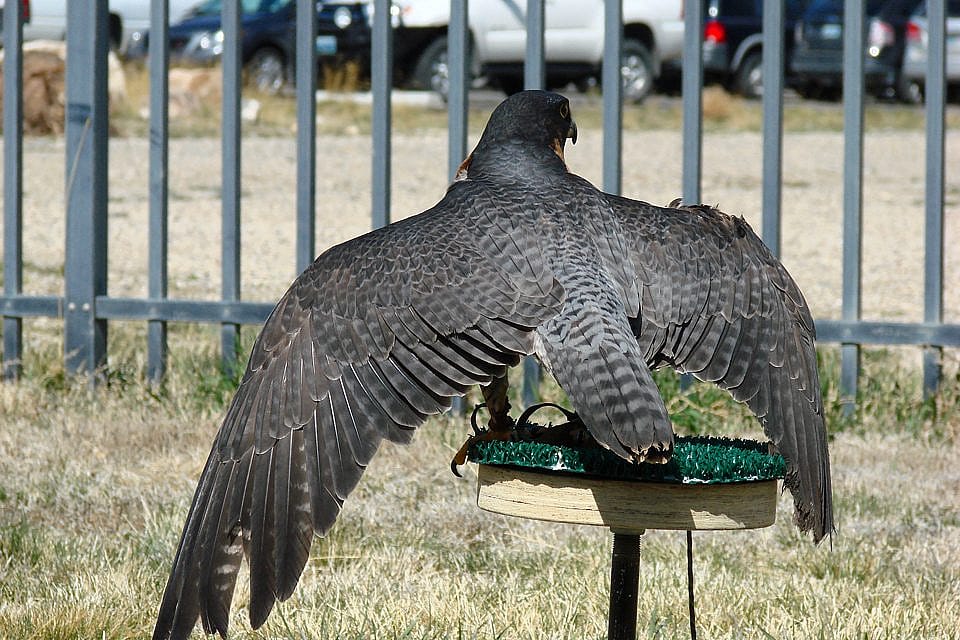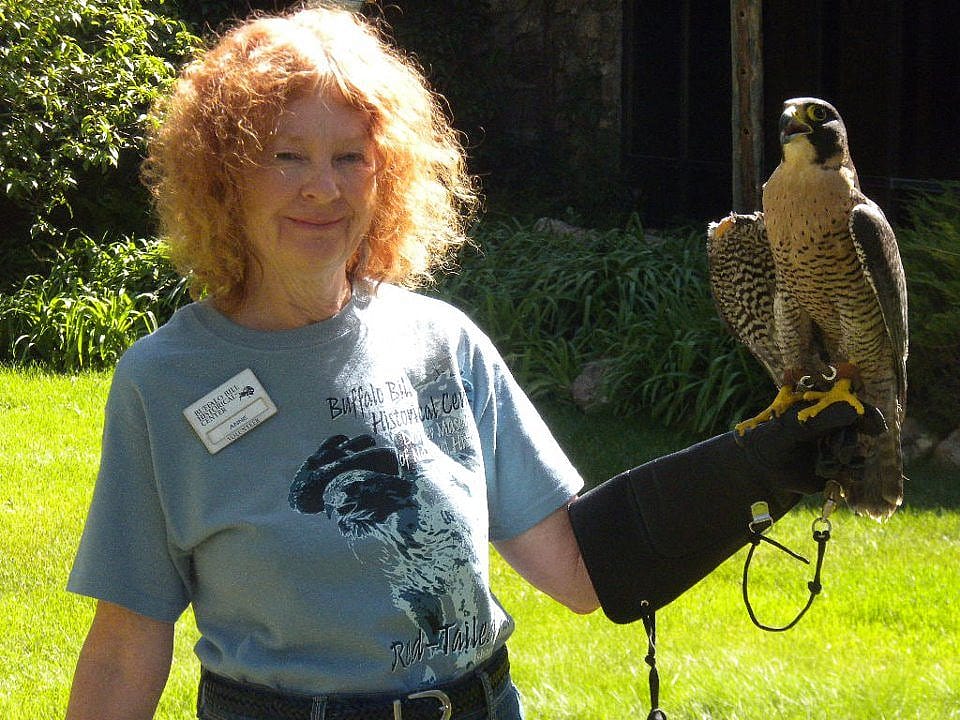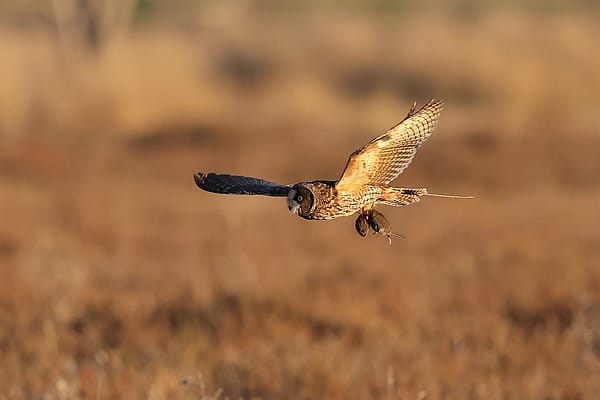
Hayabusa the peregrine falcon makes my heart flutter
The first time I saw a peregrine falcon I was on an outing to Yellowstone National Park, sponsored by the Buffalo Bill Historical Center and led by Dr. Charles Preston. Peering across the canyon, Dr. Preston pointed out a beautiful, sleek, blue and black bird wearing a black hood. Cupid shot an arrow through my heart and I fell in love. Dr. Preston informed us that she was incubating eggs. Huh? I couldn’t see a nest! Where was the nest? All I saw was a gorgeous bird, lying on a canyon outcropping. As it turns out, peregrines do not build nests. They simply make a shallow “scrape” and lay their eggs in it. These birds love to nest in high places, such as cliff edges or on tall human-made structures. She never stood up so I never saw any more than her back, but I was smitten. I could have stood there for hours with my scope aimed at her.
Hayabusa is surely the princess of the mews. When I first saw her, standing with her head held high, “princess” was the word that popped into my mind. She is a free spirit. Elegant and stately. Beautiful in colors, stature, and form—and she seems to know it. Hayabusa has style! I had mentioned in my blog about Isham, that he was like a little prince surveying his realm. When overlooking his kingdom, Isham does it in a serious, aloof manner, taking everything in with one gaze. Hayabusa’s style, however, is to be constantly on alert, always aware of everything that is going on around her. Her head swings from direction to direction as sounds and movements catch her attention. Watching her, I have come to believe that she enjoys her time in the public where she can “people watch” and they can admire her obvious beauty. She primps, she shakes, and she holds her head high as if to say, “It is only right that you should admire my great presence, and amazing beauty.”
Haya, as we call her for short, was the third bird that I learned to work with.
When I first began to learn how to convince Hayabusa to step up onto my glove, I would go into her mew with a quail drumstick and show it to her. With the food award, I was able to get her to step up without my taking a hold of her jesses. Once she was on the glove I could lock her jesses into my fingers as she ate. I no longer entice her with an award as our basic training with each other is over. We know each other now and sometimes she will let me walk right up to her and on my command of, “Step up,” she will step right onto my glove and wait as I gather up her jesses, place the swivel and leash onto them, and tie her to my glove. I cannot, however, be assured that this will always happen, as she may try to evade me by jumping away. When she is not cooperative, I try to get a hold of at least one jess. I then wait. Since Haya is very observant, she will look down and notice the jess in my hand. I then touch her toe and give the step up command and she almost always will then step up, allowing her royal presence to grace my glove.
Haya rouses a lot when she is sitting on my glove, which means she shakes her feathers out. It always looks so cute when she raises her feathers then gives her little shake. This is one sign that she is comfortable on my glove but it is also a way for her to shake her feathers into place. After all, she is a princess and she needs to keep her appearance at its very best. When she rouses, it always makes me want to shake my body along with her. I resist the urge to do so and usually, but not always, am successful at not doing “the Haya shake.”
Since meeting Hayabusa I have looked at many photographs of other peregrine falcons. Maybe I’m prejudiced but I really think she is one of the most beautiful examples of this wonderful species. I love her tawny breast color. Subspecies of falcons can have different coloring and some are actually white where Hayabusa is tawny colored. I am not saying that a falcon with a white pattern is less magnificent than Haya, but to me, her coloration is more pleasing.
Haya has taught me not only to love her, but to love all peregrines. She is not only beautiful to look at, but also intelligent. An example of this intelligence was an incident that happened after Melissa placed a small heater in her mew this winter. Haya doesn’t miss anything so of course she noticed this new thing in her room and she quickly figured out what the heater was for and put it to good use. Hayabusa loves to bathe, and the next day Melissa came into the mews to find Haya drying herself in front of her heater.
As elegant and gorgeous as Hayabusa is, she has some very unlady-like habits. For one thing, Hayabusa gobbles her food. I don’t know about you, but my mother always reminded me not to gobble my food but to take my time to chew. Of course falcons and other raptors don’t have the ability to chew their food, but Haya races through her food. If she has a quail, feathers are flying every which way. When Hayabusa has the leg of a chick, she slurps it down with the feet disappearing down her throat last. This often draws laughter from our visitors. It kind of reminds me of slurping down a spaghetti noodle—something that I was strictly told by my mother was absolutely forbidden. Haya’s manners could use a little refining.
Still, because of her eating habits, she is willing to eat before a crowd and it is fun to feed her on the glove. Melissa has worked this into our summer program, feeding Haya on the glove as a child races her with a small orange. As the race with the child begins, Haya tenses. She sees the food and locks her gaze upon it. She is intent on only one thing: obtaining the food item whether chick, quail, or mouse. She quivers slightly. Melissa counts down, “On your marks, get set…” Haya is all huntress—sometimes jerking her head toward the food. “GO!” The attack: she lunges her head forward, snatching the food the second I offer it to her and moving it into her talons so that it is held tight to my glove. One would expect her to immediately begin to feed but she pauses, checking out her competition, then looks again at the food item held below her talons. She may look around briefly, checking out the crowd. Maybe she is checking to be sure no thieves are near or maybe she is making sure all eyes are focused on her—she is such a Diva! Soon, however, all etiquette is forgotten as she tears into her food and gobbles it down as fast as she can. Although her pause gives the child a slight head start, Haya still usually wins.
You would think she would feak (wipe her beak off against my glove) after her feast but she continues to stand with her beak sometimes covered with scraps of meat. She doesn’t look much like a princess then even though she is still standing with her head held high. I would love to reach out and wipe her beak for her! When I whisper, “You should wipe your beak,” she looks at me with disdain. Hayabusa behaves in such a gluttonous way that you would think we were starving her, but we monitor each of our birds’ weights so that they are neither too heavy nor too light. The item that she is devouring is actually part of that days’ normal meal.
And how does Haya feel about me? I adore this beautiful, sleek bird and she is so well-behaved for me. It seems, however, that I am getting a misrepresentation of what it is like being a handler for a falcon so I am getting spoiled with this bird. According to Melissa, falcons are very high-strung, often one of the harder birds to handle. Haya has her moments but generally she is a good girl. She observes me, she accepts me, but no matter how much I may wish it she will never love me. I am part of her realm, someone whom she can trust and doesn’t have to keep her eye on when she has more interesting new things to be observing. Even this varies with how often I pick her up. If it has been a while she is more likely to resist, flying from perch to perch and even to the ground, giving her best effort not to be picked up. If she is with me frequently, she is more cooperative. Even when we have been apart for a time, however, I am sure she has not forgotten me because once she is on my glove she sits comfortably, rouses, and tunes into everything around her. She is a wild creature who has adjusted to a life she was never meant for and in her own way is making peace with what life has dealt her. Now Haya’s job is to be an ambassador for all of her kind and she is playing her roll admirably.
Question from Visitors:
What is the difference between a falcon and a hawk?
Falcons have sleek, aerodynamic bodies built for speed while hawks are bulkier and built better for soaring. The feathers on a falcon’s back are stiff and compact, allowing them to slip through the air with less resistance while diving toward their prey. In relation to the size of their bodies, falcons have long, pointed wings and the bony protrusion above their eyes is smaller than hawks. Falcons also have longer, thin toes which they use to grab their prey after hitting it with their feet. The upper mandible of a falcon has a tomial tooth, a tooth-like projection behind the tip of the upper bill. The lower bill has a notch that the tomial tooth fits into. This is used to bite the neck of their prey if hitting it with their feet does not kill it. The bite severs the vertebra and spinal cord of the prey. Falcons and shrikes are the only birds to have a tomial tooth.
Written By
Anne Hay
Anne Hay has a Bachelor's degree in Elementary Education and a Master's in Computers in Education. She spent most of her working years teaching third grade at Livingston School in Cody, Wyoming. After retiring she began doing a variety of volunteer work for the Buffalo Bill Center of the West’s Draper Natural History Museum. Anne loves nature and has a concern for the environment. She believes that educating the public, so that they will have a better understanding and appreciation for the natural world, is very important. Because of this belief, volunteering at the Center is a perfect fit. She spends time in the Draper Lab, observing eagle nests for Dr. Charles Preston’s long-term research project on nesting golden eagles, writing observation reports of raptor sightings in the Bighorn Basin, and working with the Draper Museum Raptor Experience. Anne states that, “Having a bird on my glove, is one of my all time favorite things in life.”

















